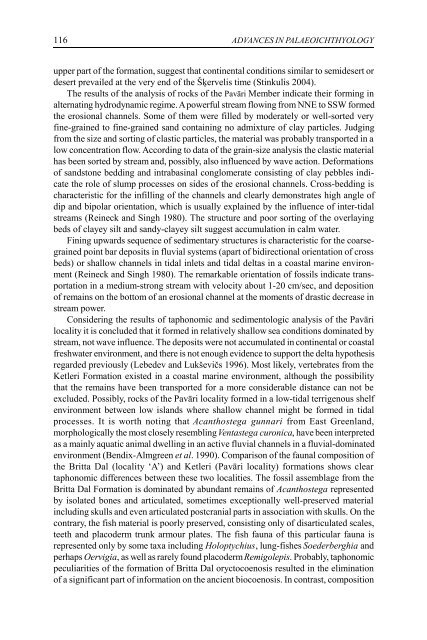Zemes un vides zinātnes Earth and Environment Sciences - Latvijas ...
Zemes un vides zinātnes Earth and Environment Sciences - Latvijas ...
Zemes un vides zinātnes Earth and Environment Sciences - Latvijas ...
You also want an ePaper? Increase the reach of your titles
YUMPU automatically turns print PDFs into web optimized ePapers that Google loves.
116 ADVANCES IN PALAEOICHTHYOLOGY<br />
upper part of the formation, suggest that continental conditions similar to semidesert or<br />
desert prevailed at the very end of the Šķervelis time (Stinkulis 2004).<br />
The results of the analysis of rocks of the Pavāri Member indicate their forming in<br />
alternating hydrodynamic regime. A powerful stream flowing from NNE to SSW formed<br />
the erosional channels. Some of them were filled by moderately or well-sorted very<br />
fine-grained to fine-grained s<strong>and</strong> containing no admixture of clay particles. Judging<br />
from the size <strong>and</strong> sorting of clastic particles, the material was probably transported in a<br />
low concentration flow. According to data of the grain-size analysis the clastic material<br />
has been sorted by stream <strong>and</strong>, possibly, also influenced by wave action. Deformations<br />
of s<strong>and</strong>stone bedding <strong>and</strong> intrabasinal conglomerate consisting of clay pebbles indicate<br />
the role of slump processes on sides of the erosional channels. Cross-bedding is<br />
characteristic for the infilling of the channels <strong>and</strong> clearly demonstrates high angle of<br />
dip <strong>and</strong> bipolar orientation, which is usually explained by the influence of inter-tidal<br />
streams (Reineck <strong>and</strong> Singh 1980). The structure <strong>and</strong> poor sorting of the overlaying<br />
beds of clayey silt <strong>and</strong> s<strong>and</strong>y-clayey silt suggest accumulation in calm water.<br />
Fining upwards sequence of sedimentary structures is characteristic for the coarsegrained<br />
point bar deposits in fluvial systems (apart of bidirectional orientation of cross<br />
beds) or shallow channels in tidal inlets <strong>and</strong> tidal deltas in a coastal marine environment<br />
(Reineck <strong>and</strong> Singh 1980). The remarkable orientation of fossils indicate transportation<br />
in a medium-strong stream with velocity about 1-20 cm/sec, <strong>and</strong> deposition<br />
of remains on the bottom of an erosional channel at the moments of drastic decrease in<br />
stream power.<br />
Considering the results of taphonomic <strong>and</strong> sedimentologic analysis of the Pavāri<br />
locality it is concluded that it formed in relatively shallow sea conditions dominated by<br />
stream, not wave influence. The deposits were not accumulated in continental or coastal<br />
freshwater environment, <strong>and</strong> there is not enough evidence to support the delta hypothesis<br />
regarded previously (Lebedev <strong>and</strong> Lukševičs 1996). Most likely, vertebrates from the<br />
Ketleri Formation existed in a coastal marine environment, although the possibility<br />
that the remains have been transported for a more considerable distance can not be<br />
excluded. Possibly, rocks of the Pavāri locality formed in a low-tidal terrigenous shelf<br />
environment between low isl<strong>and</strong>s where shallow channel might be formed in tidal<br />
processes. It is worth noting that Acanthostega g<strong>un</strong>nari from East Greenl<strong>and</strong>,<br />
morphologically the most closely resembling Ventastega curonica, have been interpreted<br />
as a mainly aquatic animal dwelling in an active fluvial channels in a fluvial-dominated<br />
environment (Bendix-Almgreen et al. 1990). Comparison of the fa<strong>un</strong>al composition of<br />
the Britta Dal (locality ‘A’) <strong>and</strong> Ketleri (Pavāri locality) formations shows clear<br />
taphonomic differences between these two localities. The fossil assemblage from the<br />
Britta Dal Formation is dominated by ab<strong>un</strong>dant remains of Acanthostega represented<br />
by isolated bones <strong>and</strong> articulated, sometimes exceptionally well-preserved material<br />
including skulls <strong>and</strong> even articulated postcranial parts in association with skulls. On the<br />
contrary, the fish material is poorly preserved, consisting only of disarticulated scales,<br />
teeth <strong>and</strong> placoderm tr<strong>un</strong>k armour plates. The fish fa<strong>un</strong>a of this particular fa<strong>un</strong>a is<br />
represented only by some taxa including Holoptychius, l<strong>un</strong>g-fishes Soederberghia <strong>and</strong><br />
perhaps Oervigia, as well as rarely fo<strong>un</strong>d placoderm Remigolepis. Probably, taphonomic<br />
peculiarities of the formation of Britta Dal oryctocoenosis resulted in the elimination<br />
of a significant part of information on the ancient biocoenosis. In contrast, composition
















